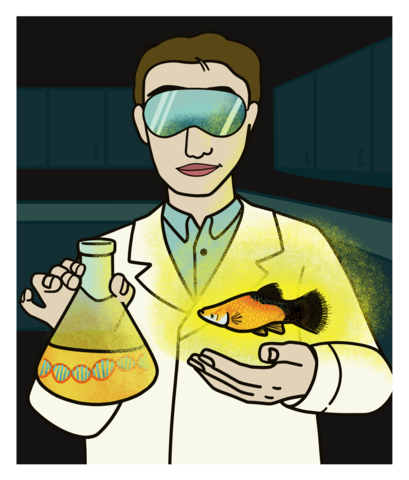Texas State’s Xiphophorus Genetic Stock Center has identified a long-sought-out gene in laboratory fish that provides a new understanding of cancer formation and speciation.
The research that led to the discovery of the gene, in November 2020, stemmed from an extensive and long-established program that focused on hybridizing (cross breeding) the southern platyfish Xiphophorus maculatus and the green swordtail Xiphophorus hellerii.
A number of hybrid offspring developed cancer due to the two species’ genetic incompatibility. The hybrids became a valuable model system for cancer research and for studying the genetics of hybridization.
The gene responsible for the development of cancer in southern platyfish, EGFR, was identified by previous researchers. But its counterpart, R(Diff), the gene that regulates tumor creation, was not recognized until recently.
The study into R(Diff) was led by Texas State’s co-principal investigator, Yuan Lu, for the Xiphophorus Genetic Stock Center. Despite the monumental discovery, Lu says without the many years of previous research on the topic, identifying the gene would have been nearly impossible.
“This is almost a 100-year project,” Lu says. “What I do is nothing new. It is not a new idea; it’s just new technology. By leveraging all those resources, we were able to make the discovery. You know, standing on the shoulder of giants.”
Lu, his two students, Angel Sandoval and Sarah Voss, along with Will Boswell, Mikki Boswell, Markita Savage and Ronald Walter of the Xiphophorus Genetic Stock Center, Manfred Schartl and Susanne Kneitz of the University of Würzburg in Würzburg, Germany, Zhao Lai and Christi Walter of UT Health San Antonio, as well as Wes Warren of the University of Missouri, Columbia, make up the research team that made the identification.
Their findings are published in the journal titled Proceedings of the National Academy of Sciences (PNAS) as “Oncogenic allelic interaction in Xiphophorus highlights hybrid incompatibility.”
Lu began his work with the project in 2018 after receiving a research grant, 100 animals from the Nevada stock center and 200 animals from Schartl collected over the last 10 years which he and his two students, Voss and Sandoval, used as the basis of a genetic map.
By early 2019, Lu and his students identified a region that was about 100 kilometers long and was considered a good candidate for the EGFR locus.
The EGFR gene found in southern platyfish normally triggers the formation of their tumors due to tumor regulators that the species co-evolved. However, the defense mechanism against the cancer is diminished once hybridization with the green swordtail is performed.
The platyfish EGFR gene is a similar form of EGFR that has been a propulsive oncogene for human cancer for over 40 years — an area of interest to Lu and other researchers.
“EGFR is related to 70% of human cancer,” Lu says. “Either mutated genes in human cancer or overexpressed and somehow dysregulated, the driving gene for tumors being an EGFR just makes perfect sense.”
EGFR was first identified by Schartl’s team in Germany in 1989.
“It’s a gene which is also in humans that regulates certain signaling processes in the cell, which we know occurs [in] human cancer,” Schartl says. “It even predicted findings which were made 10-15 years later in human melanoma because it’s the same cancer pathway.”
Although Schartl’s main institution is in Germany, because of his status as a professor, he gained the ability to travel to other places for research and decided working with Texas State’s Xiphophorus Genetic Stock Center would be beneficial to the project.
“In science, it’s a lot about competition, but we decided that it’s better to join forces and work together,” Schartl says. “And it ended up being really wonderful people at Texas State [that] have this collegial appreciation of science.”
After the identification of EGFR, Lu and other researchers began to theorize the different possibilities with the identification of its counterpart — the gene that was responsible for the suppression of tumors.
“If we can know what the tumor suppressor was and combine it with the knowledge we learn from the fish to human, because cancer researchers have studied with EGFR mutation for 40 years, yet, we still cannot control tumor using EGFR antagonists,” Lu says, which was the reason locating the tumor suppressor gene, R(Diff), became the main focus.
“Although 70% of human tumors are related to EGFR, only three types of cancer were responsive to EGFR antagonists,” Lu adds.
The search to find the suppressor gene was previously centered in New York at the genetic stock center, but when the last of the researchers at the center retired, all of the genetic material and research was transferred to Texas State, an action Schartl says placed a focus on San Marcos.
“The finding of this gene has put San Marcos on the map for cancer research,” Schartl says. “I was the guy who discovered the bad gene, and they were the guys looking for the good gene, so we have collaborated since then.”
Even with the identification of the tumor-suppressing gene, there is still an air of mystery surrounding the specific ways the gene can be used for future cancer research in humans. However, because of the research structure, Schartl says the door is left open for a multitude of possibilities.
“You’ll see there are still a lot of questions, more things to do, but it’s a wonderful system because tumors are so variable, especially most tumors in humans because they arise by extra genius events like exposure to carcinogens and so on,” Schartl says. “But even though these are all random events, here in this genetic system, we have a very reproducible situation; we can always do the same crossing, and the fish that we get today are the same that we got in our crossings 20 or 30 years ago. So, it has the advantage of being a defined genetic system, which makes it very attractive for a scientist.”
Schartl says the identification of R(Diff) to cancer research is invaluable as it provides new insight into the different ways researchers can approach the disease.
“There are many ways that this could be used for cancer research,” Schartl says. “There are therapeutically strategies, small molecules, immunotherapy and it also might open a way for diagnostics.”
Sandoval, a biochemistry senior, has been involved with the project for over two years and was first inspired to participate in the study due to his passion for cancer research.
“Since before my freshman year, I knew I wanted to do research in cancer and when you say that it’s very broad [you are] right because there’s a million types of cancers,” Sandoval says. “Each one arises from a million different reasons, so if you come into research saying you want to research cancer, people are going to look at you like this kid who doesn’t know what research is.”
With the identification of R(Diff), Sandoval is enthusiastic about the future and what it means for cancer patients but is also aware of the time innovations will take, as well as the reality that it will not likely be the end-all cure for all cancers.
“Now we can use CRISPR [Clustered Regularly Interspaced Short Palindromic Repeats] to start inserting this gene, potentially in humans, which I think will take about 20 years,” Sandoval says. “And that’s the tricky part. There are many different types of cancers caused by many different factors, so I’m not saying that if we inserted this gene into humans that they won’t get cancer anymore. It might help like 40% of people not get cancer but [not that] other 60%.”
Schartl and researchers are still hopeful their findings will lead to great success in the future of cancer research.
“It’s a breakthrough,” Schartl says. “Now we know all the players, and now that we know the players, we can begin to understand how they play.”
Categories:
Texas State researchers identify cancer gene in laboratory fish
Kiana Burks, News Contributor
February 9, 2021

hybrid fish
0
Donate to The University Star
Your donation will support the student journalists of Texas State University. Your contribution will allow us to purchase equipment and cover our annual website hosting costs.
More to Discover












